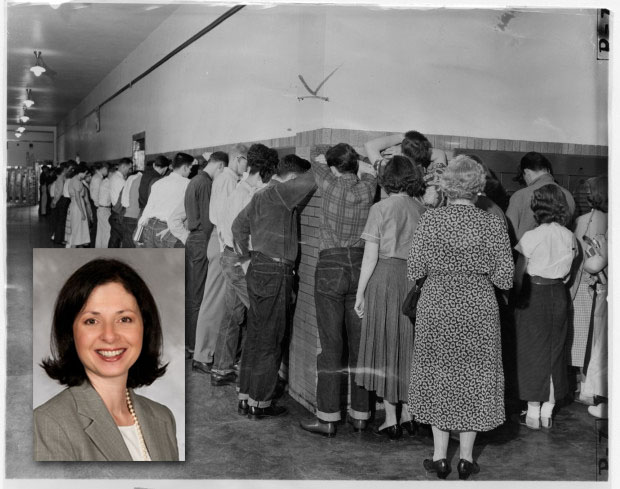Betraying Trust : Institutionalized Chemical, Biological, Radiological Civilian Exposure
"In Winnipeg, they said they were testing what they characterized as a chemical fog to protect Winnipeg in the event of a Russian attack."
"They characterized it as a defensive study when it was actually an offensive study."
"The U.S. was very aggressive. Canada seemed less on board as I read through the documentation."
Lisa Martino-Taylor, professor of sociology, St.Louis Community College, St.Louis Missouri
 |
In the 1950s and 1960s Canada participated in open-air experiments conducted by the United States military reflecting a tripartite agreement between Canada, the United States and Britain. What was missing from this agreement was an openness in communication, where the United States would fully brief its Canadian partners that it intended to spray a known carcinogen (cadmium) over Winnipeg, Manitoba, placing its 300,000 residents at risk.
What resulted was that people in Manitoba and Alberta were exposed to deadly carcinogens during the Cold War. These tests were carried out by the U.S. military linked to weapons such as radioactive components whose purpose was to attack the Soviet Union; the tests were meant to discern the effects on human populations. So hundreds of thousands of Canadians (and Americans as well) were being used as guinea pigs in gigantic tests of the feasibility of wartime use of chemical weaponry. Weapons, in other words, of mass destruction.
Winnipeggers unaware of what was happening, were exposed to six kilograms of zinc cadmium sulphide, sprayed over their city from American army planes between July 9, 1953 and August 1, 1953. The experiments were repeated after a lapse of eleven years, this time in Suffield and Medicine Hat, Alberta for the purpose of ongoing testing of weaponry merging radioactive, chemical and biological weapons in tandem.
Sociologist Lisa Maretino-Taylor undertook research into the situation to reveal the extent of the secret tests launched on unsuspecting Canadians and Americans. According to documents obtained by Dr. Martino-Taylor, author of "Behind the Fog: How the U.S. Cold War Radiological Weapons Program Exposed Innocent Americans", local governments had not been informed and had no idea of what was happening.
In documents held by Canada and the United States, the tests were identified singly as biological and chemical, despite that the two were in fact combined with radiological components. Of particular usefulness to the U.S. army was the zinc cadmium sulphide whose use as a fluorescent tracer would help determine radioactive fallout from a weapon meant for use on the Soviets, to determine how it would travel through wind currents.
Odourless, colourless and minuscule enough to render them undetectable to the naked eye, the size of the particulate matter made more threatening to health, lodging deep in the human respiratory system. The U.S. army suggested some of its experiments including phosphorus-32, a radioactive material and VX, a nerve agent be used in Suffield to test its production of a radioactive nerve agent using the two properties. Plans were underway for 100 pounds of VX to be delivered to Suffield.
In 1964 a memorandum from Suffield spoke of the U.S. planning to visit to "discuss the use of radioactive tracer techniques in chemical weapons trials". The Army took stock of the number of hospitals and hospital beds available in the area in preparation for tests involving a bacteria, supposedly harmless. Canadians were not the sole targets for U.S. military tests; their own citizens came in for special attention as well.
In Nashville pregnant women became research subjects to determine if, ingesting a radioactive cocktail (without their knowledge and consent) it could be determined whether their babies would be affected. Children were given radioactive oatmeal purporting to be involved with a "science club". Dr. Martino-Taylor discovered that the open-air radiological weapons expert responsible for designing the experiments spoke of the chemical as "toxic", labelled poison.
During the Second World War, Canada itself conducted mustard gas tests on 3,000 volunteers at a Suffield military base. CIA experiments conducted in Quebec on subjects not informed of the purpose of the experiments were meant to analyze whether it was possible to eliminate memories with the use of LSD and electroshocks. Infamously, many of those people exposed to these experiments who were at the time inmates of psychiatric hospitals, suffered life-long after-effects.
 |
| During the 1964–1973 Vietnam war, Canadians helped American forces test the herbicide Agent Orange, which was spread over the villages and jungles of Vietnam. Photo Credit: United Press International. |
Labels: Biological Weapons, Canada, Chemical Weapons, Research, United States

<< Home